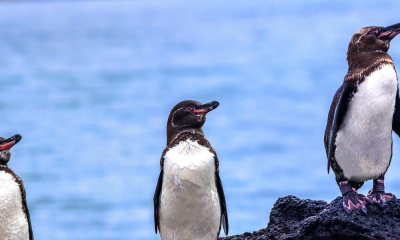
The Galapagos penguin is the only penguin species found in the north of the equator. Native to the Galapagos Islands, it is believed to survive the warmer environment because of the Humboldt Current that brings cold waters to the islands. One of the smaller penguins, it has bare patches of skin around its eyes and at the base of its beak.
Based on their small geographic distribution, their already naturally low numbers, and their decreasing population size, Galapagos penguins are considered endangered (highly vulnerable to extinction). Some individuals are accidentally caught by fishers targeting other species, but the two biggest issues for Galapagos penguin populations are climate variability and invasive species. The cyclical, large-scale climate phenomenon known as El Niño significantly reduces the amount of food available to Galapagos penguins, causing them to skip nesting. In severe cases, these events can lead to starvation of the adults. While El Nino is a natural phenomenon, there is some growing evidence that human activities acting on the climate system as a whole may increase the severity or frequency of El Nino events. Perhaps a greater risk to this species is the introduction of two very different species, both of which threaten adult and juvenile Galapagos penguins. Introduced cats attack and eat these penguins and have contributed to a direct reduction in population size. Introduced mosquitoes carry avian flu, a virus that is particularly deadly to Galapagos penguins and its close relatives. An outbreak of this flu could easily spread through large swaths of the remaining Galapagos penguin population. Finally, as Galapagos penguins (like all penguins) are air breathers that regularly come to the sea surface, an oil spill in the Galapagos Islands could be a major threat to this rare, coastal species. Scientists estimate that there are fewer than 600 breeding pairs of Galapagos penguins alive today, so without continuing conservation measures, the species could be at risk of being lost.
Credit : Oceana
Picture Credit : Google




